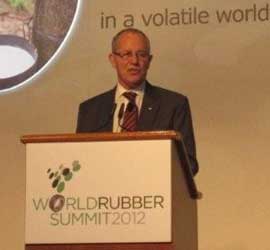 |
 |
In this Edition May 2012 |
LEAD FEATURE |
COMPANY NEWS |
MATERIALS NEWS |
MACHINERY NEWS |
EXHIBITION NEWS |
INJECTION MOULDING ASIA |
RUBBER JOURNAL ASIA |
PRA June-July 2012 Electronic Issue Now Available |
Lead Feature
Lanxess prepares for green tyre demand
 |
In Singapore, Lanxessis building its largest butyl rubber plant in Jurong Island. The facility, estimated to be worth SG$650 million, will go on stream in Q1 2013 with 100,000 tonnes/year capacity.
Later this year, the company will break ground for a new plant for neodymium-polybutadiene(Nd-PBR) also in the same location in Singapore. The facility, worth SG$325 million, will go on stream in H1 2015 with a capacity of 140,000 tonnes of Nd-PBR.
During the World Rubber Summit, Commander announced that the firm's team in Nantong, China, was pushing the buttons at the new nitrile butadiene rubber (NBR) plant, which has an initial capacity of 30,000 tonnes/year. Touted as a modern facility, the plant is part of a 50:50 joint venture with Taiwan's TSRC Corp. Addressing the needs presented by rapid urbanisation and growing mobility, the plant produces the highest form of NBR that is claimed to have a higher resistance to oil than conventional rubbers.
A few days after the announcement, Lanxess revealedanother investment worth EUR30 million for its production site for high-performance rubber in Port Jerome, France. The development will help increase productivity and energy efficiency in the production of Nd-PBR and solution styrene-butadiene (SSBR) at the site by 2015. These rubber grades are used primarily for the production of green tyres, which is the fastest-growing segment of the global tyre industry.
In Zwijndrecht, Belgium, it has increased capacity of its facility to 10% to reach 150,000 tonnes/year of regular butyl and halobutyl synthetic rubber per year. It also built two new pilot plants at the same location for the development of its butyl rubber technology.
Forecasted to have annual growth rates of around 10%, green tyre demand will be driven by the megatrends mobility and urbanisation, particularly in Asia and Latin America. In China alone, there are about 225 million vehicles and by 2030, 800 million people in China will achieve middle-class status.
Lanxess also expects increased demand in Europe as a result of the EU labelling requirement for tyres that enters into force in November 2012. EU is calling for 21% reduction of CO2 emissions of newly registered vehicles by 2020 and by 2014, all new vehicles should be equipped with new tyres, and only those with approved tyres can be sold.
"That is all good news for synthetic rubber. The number of vehicles will triple and those vehicles will need fuel-saving tyres. Synthetic rubber is clearly in the right place," enthused Commander, during his presentation at the World Rubber Summit.
Commander also said that green tyres can help reduce 5% to 7% of fuel consumption without sacrificing safety and durability. A green tyre is estimated to cost between EUR20 to EUR50 more than a conventional tyre and in two years, four green tyrescan save an average driver (12,500 km peryear) up to EUR100 in fuel, according to a study commissioned by the EU.


